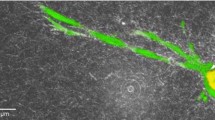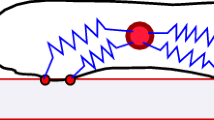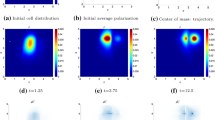Abstract
Cells move by run and tumble, a kind of dynamics in which the cell alternates runs over straight lines and re-orientations. This erratic motion may be influenced by external factors, like chemicals, nutrients, the extra-cellular matrix, in the sense that the cell measures the external field and elaborates the signal eventually adapting its dynamics. We propose a kinetic transport equation implementing a velocity-jump process in which the transition probability takes into account a double bias, which acts, respectively, on the choice of the direction of motion and of the speed. The double bias depends on two different non-local sensing cues coming from the external environment. We analyze how the size of the cell and the way of sensing the environment with respect to the variation of the external fields affect the cell population dynamics by recovering an appropriate macroscopic limit and directly integrating the kinetic transport equation. A comparison between the solutions of the transport equation and of the proper macroscopic limit is also performed.











Similar content being viewed by others
References
Adler J (1966) Chemotaxis in bacteria. Science 153(3737):708–116
Alt W (1980) Biased random walk models for chemotaxis and related diffusion approximations. J Math Biol 9(2):147–177
Ambrosi D, Gamba A, Serini G (2005) Cell directional persistence and chemotaxis in vascular morphogenesis. Bull Math Biol 67(1):195–195
Arduino A, Preziosi L (2015) A multiphase model of tumour segregation in situ by a heterogeneous extracellular matrix. Int J Non Linear Mech 75:22–30
Armstrong NJ, Painter KJ, Sherratt JA (2006) A continuum approach to modelling cell–cell adhesion. J Theor Biol 243(1):98–113
Berg HC (1983) Random walks in biology, Revised edn. Princeton University Press, Princeton
Berg H, Purcell E (1977) Physics of chemoreception. Biophys J 20(2):193–219
Bisi M, Carrillo JA, Lods B (2008) Equilibrium solution to the inelastic Boltzmann equation driven by a particle bath. J Stat Phys 133(5):841–870
Block SM, Segall JE, Berg HC (1983) Adaptation kinetics in bacterial chemotaxis. J Bacteriol 154(1):312–323
Boekhorst V, Preziosi L, Friedl P (2016) Plasticity of cell migration in vivo and in silico. Ann Rev Cell Dev Biol 32:491–526
Buttenschön A, Hillen T, Gerisch A, Painter KJ (2018) A space-jump derivation for non-local models of cell–cell adhesion and non-local chemotaxis. J Math Biol 76(1):429–456
Carrillo J, Hoffmann F, Eftimie R (2015) Non-local kinetic and macroscopic models for self-organised animal aggregations. Kinet Relat Models 8:413
Cercignani C (1987) The Boltzmann equation and its applications. Springer, New York
Chalub FACC, Markowich PA, Perthame B, Schmeiser C (2004) Kinetic models for chemotaxis and their drift-diffusion limits. Monatshefte für Mathematik 142(1):123–141
Chauviere A, Hillen T, Preziosi L (2007b) Modeling the motion of a cell population in the extracellular matrix. Conf Publ 2007(Supplemental volume):250–259
Chauviere A, Hillen T, Preziosi L (2007a) Modeling cell movement in anisotropic and heterogeneous network tissues. Netw Heterog Media 2(2):333
Chauviere A, Preziosi L (2010) A mathematical framework to model migration of a cell population in the extracellular matrix. In: Chauviere A, Preziosi L, Verdier C (eds) Cell mechanics: from single scale-based models to multiscale modeling. Chapman & Hall/CRC Press, pp 279–312
Colombi A, Scianna M, Tosin A (2015) Differentiated cell behavior: a multiscale approach using measure theory. J Math Biol 71:1049–1079
Colombi A, Scianna M, Preziosi L (2017) Coherent modelling switch between pointwise and distributed representations of cell aggregates. J Math Biol 74(4):783–808
Deery WJ, Gomer RH (1999) A putative receptor mediating cell-density sensing indictyostelium. J Biol Chem 274(48):34476–34482
Devreotes P, Janetopoulos C (2003) Eukaryotic chemotaxis: distinctions between directional sensing and polarization. J Biol Chem 278(23):20445–20448
Dickinson RB (2000) A generalized transport model for biased cell migration in an anisotropic environment. J Math Biol 40(2):97–135
Eftimie R (2012) Hyperbolic and kinetic models for self-organized biological aggregations and movement: a brief review. J Math Biol 65(1):35–75
Engwer C, Hillen T, Knappitsch M, Surulescu C (2015a) Glioma follow white matter tracts: a multiscale dti-based model. J Math Biol 71(3):551–582
Engwer C, Hunt A, Surulescu C (2015b) Effective equations for anisotropic glioma spread with proliferation: a multiscale approach and comparisons with previous settings. Math Med Biol 33:435–459
Engwer C, Knappitsch M, Christina S (2016) A multiscale model for glioma spread including cell-tissue interactions and proliferation. Math Biosci Eng 13:443–460
Engwer C, Stinner C, Surulescu C (2017) On a structured multiscale model for acid-mediated tumor invasion: the effects of adhesion and proliferation. Math Models Methods Appl Sci 27:1355–1390
Filbet F, Vauchelet N (2010) Numerical simulation of a kinetic model for chemotaxis. Kinet Relat Models 3:B348–B366
Filbet F, Laurencot P, Perthame B (2005) Derivation of hyperbolic models for chemosensitive movement. J Math Biol 50:189–207
Fisher R, Merkl R, Günther G (1989) Quantitative analysis of cell motility and chemotaxis in dictyostelium discoideum by using an image processing system and a novel chemotaxis chamber providing stationary chemical gradients. J Cell Biol 108:973–84
Giverso C, Arduino A, Preziosi L (2017) How nucleus mechanics and ECM microstructure influence the invasion of single cells and multicellular aggregates. Bull Math Biol 80:1–29
Hillen T (2006) M5 mesoscopic and macroscopic models for mesenchymal motion. J Math Biol 53:585–616
Hillen T, Othmer HG (2000) The diffusion limit of transport equations derived from velocity-jump processes. SIAM J Appl Math 61:751–775
Hillen T, Painter KJ (2008) A user’s guide to pde models for chemotaxis. J Math Biol 58(1):183–217
Hillen T, Painter KJ, Schmeiser C (2007) Global existence for chemotaxis with finite sampling radius. Discrete Contin Dyn Syst B 7(1):125–144
Hwang H, Kang K, Stevens A (2005) Drift-diffusion limits of kinetic models for chemotaxis: a generalization. Discrete Contin Dyn Syst B 5(2):319–334
Koshland DE (1981) Bacterial chemotaxis as a model behavioral system. Q Rev Biol 56(4):473–474
Lapidus R, Schiller R (1976) Model for the chemotactic response of a bacterial population. Biophys J 16(7):779–789
Lemou M, Mieussens L (2008) A new asymptotic preserving scheme based on micro-macro formulation for linear kinetic equations in the diffusion limit. SIAM J Sci Comput 31(1):334–368
Lods B (2005) Semigroup generation propertiesof streaming operators with noncontractive boundary conditions. Math Comput Model 42:1441–1462
Othmer H, Hillen T (2002) The diffusion limit of transport equations ii: chemotaxis equations. SIAM J Appl Math 62:1222–1250
Othmer H, Stevens A (2001) Aggregation, blowup, and collapse: the ABC’s of taxis in reinforced random walks. SIAM J Appl Math 57(4):1044–1081
Othmer HG, Dunbar SR, Alt W (1988) Models of dispersal in biological systems. J Math Biol 26(3):263–298
Painter KJ (2008) Modelling cell migration strategies in the extracellular matrix. J Math Biol 58(4):511
Painter JK, Hillen T (2002) Volume-filling and quorum-sensing in models for chemosensitive movement. Can Appl Math Q 10:501–543
Painter KJ, Sherratt JA (2003) Modelling the movement of interacting cell populations. J Theor Biol 225(3):327–339
Painter KJ, Armstrong NJ, Sherratt JA (2010) The impact of adhesion on cellular invasion processes in cancer and development. J Theor Biol 264(3):1057–1067
Painter KJ, Bloomfield MJ, Sherratt JA, Gerisch A (2015) A nonlocal model for contact attraction and repulsion in heterogeneous cell populations. Bull Math Biol 77(6):1132–1165
Palcewski A (1992) Velocity averaging for boundary value problems in nonlinear kinetic theory and mathematical aspects of hyperbolic systems. In: Boffi V, Franco B, Giuseppe T (eds) Series on advances in mathematics for applied sciences. World Scientific Publishing Company, Singapore
Palecek S, Loftus J, Ginsberg HM, Lauffenburger AD, Horwitz A (1997) Integrin-ligand binding properties govern cell migration speed through cell-substratum adhesiveness. Nature 385:537–40
Paul AD, John AS, John AQ, Steven MA, Douglas AL (1993) Maximal migration of human smooth muscle cells on fibronectin and type IV collagen occurs at an intermediate attachment strength. J Cell Biol 122:729–737
Pettersson R (2004) On solutions to the linear Boltzmann equation for granular gases. Transp Theory Stat Phys 33(5–7):527–543
Plaza RG (2019) Derivation of a bacterial nutrient-taxis system with doubly degenerate cross-diffusion as the parabolic limit of a velocity-jump process. J Math Biol 78(6):1681–1711
Scianna M, Preziosi L (2013) Modeling the influence of nucleus elasticity on cell invasion in fiber networks and microchannels. J Theor Biol 317:394–406
Scianna M, Preziosi L, Wolf K (2013) A cellular Potts model simulating cell migration on and in matrix environments. Math Biosci Eng 10:235–61
Scianna M, Preziosi L (2014) A cellular Potts model for the MMP-dependent and-independent cancer cell migration in matrix microtracks of different dimensions. Comput Mech 53:485–497
Soll D, Wessels D (1998) Motion analysis of living cells. Techniques in modern biomedical microscopy. Wiley, New York
Stinner C, Surulescu C, Meral G (2015) A multiscale model for ph-tactic invasion with time-varying carrying capacities. IMA J Appl Math 80:1300–1321
Stroock DW (1974) Some stochastic processes which arise from a model of the motion of a bacterium. Zeitschrift für Wahrscheinlichkeitstheorie und Verwandte Gebiete 28(4):305–315
Tosin A, Frasca P (2011) Existence and approximation of probability measure solutions to models of collective behaviors. Netw Heterog Media 6(1):561
Wolf K, Te Lindert M, Krause M, Alexander S, Te Riet J, Willis AL, Hoffman RM, Figdor C, Weiss SJ, Friedl P (2013) Physical limits of cell migration: control by ECM space and nuclear deformation and tuning by proteolysis and traction force. J Cell Biol 201:1069–1084
Acknowledgements
This work was partially supported by Istituto Nazionale di Alta Matematica, Ministry of Education, Universities and Research, through the “MIUR grant Dipartimenti di Eccellenza 2018-2022”, Project no. E11G18000350001 and Compagnia San Paolo that finances NL Ph.D. scholarship.
Author information
Authors and Affiliations
Corresponding author
Additional information
Publisher's Note
Springer Nature remains neutral with regard to jurisdictional claims in published maps and institutional affiliations.
Rights and permissions
About this article
Cite this article
Loy, N., Preziosi, L. Kinetic models with non-local sensing determining cell polarization and speed according to independent cues. J. Math. Biol. 80, 373–421 (2020). https://doi.org/10.1007/s00285-019-01411-x
Received:
Revised:
Published:
Issue Date:
DOI: https://doi.org/10.1007/s00285-019-01411-x




